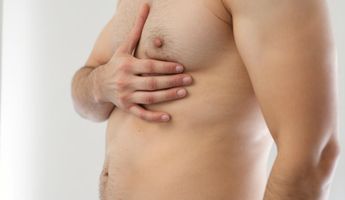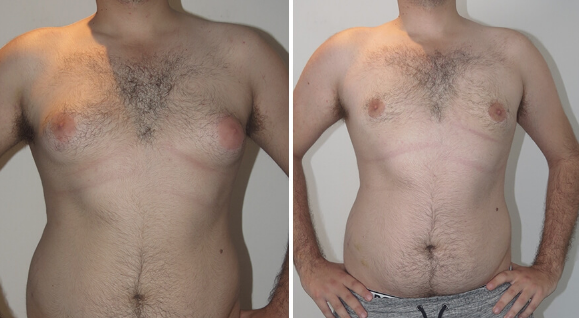Male Breast Reduction in Romania
Search and Compare the Best Clinics and Doctors at the Lowest Prices for Male Breast Reduction in Romania

Find the best clinics for Male Breast Reduction in Romania
No clinics available
India offers the best prices Worldwide
Price: $ 692

- Home
- Romania
WHY US?
At Medijump, we're making medical easy. You can search, compare, discuss, and book your medical all in one place. We open the door to the best medical providers worldwide, saving you time and energy along the way, and it's all for FREE, no hidden fees, and no price markups guaranteed. So what are you waiting for?

Free

Best Price

Widest Selection

Risk-Free
What you need to know about Male Breast Reduction in Romania

Male breast reduction, also known as gynecomastia correction, is a surgical procedure to treat overdeveloped male breasts or gynecomastia – a condition in which male breasts are enlarged due to imbalance of the hormones estrogen and testosterone. The procedure is usually performed on men whose physical health is affected by the condition or men who feel uncomfortable or self-conscious about their chest. The ideal candidates for this procedure are healthy men with skin that is elastic to adjust to breast reduction.
What Does the Procedure Involve?
Male breast reduction is carried out under general anesthetic or local anesthetic with sedation. The procedure starts by making an incision around the nipple to remove fat as well as glandular tissue from the breast, as well as some excess skin. In some cases, your surgeon may also perform liposuction in conjunction with the procedure to remove fat. The final step of the procedure is closing the incisions with stitches.
How Long Should I Stay in Romania for a Male Breast Reduction Procedure?
The procedure is usually performed on an outpatient basis, meaning you can leave the hospital on the same day of the surgery. However, you should not leave Romania immediately to allow your body to recover and attend follow-up hospital checkups. Plan to stay in the country for at least 5 to 10 more days.
What's the Recovery Time for Male Breast Reduction Procedures in Romania?
The total recovery period until you can go back to your full routine can take around a month. However, some people whose jobs are not physically demanding are able to return to work as well as some of their activities in 1-2 weeks.
What sort of Aftercare is Required for Male Breast Reduction Procedures in Romania?
Your surgeon will give you detailed instructions on how to care for your surgical wounds as well as diet and exercise to avoid complications. You may need to wear a pressure garment during your recovery period to reduce bruising and swelling. To maintain the result of your surgery, make sure to maintain a healthy weight by making some healthy lifestyle changes.
What's the Success Rate of Male Breast Reduction Procedures in Romania?
The procedure is generally safe and highly successful. However, just like other types of surgery, it carries some degree of side effects and risks that you need to be aware of. The side effects and risks include skin injury, noticeable scar, permanent pigment changes in the breast, slightly mismatched nipples or breasts, loss of breast sensation, numbness, and excessive bleeding.
Are there Alternatives to Male Breast Reduction Procedures in Romania?
Male breast reduction is currently the most effective treatment to reduce enlarged male breasts. If you do not want to undergo surgery, you need to consult with your doctor about what your best options are. In some cases, your doctor may recommend liposuction to remove excess fat from your breasts, but leaving breast gland tissue intact.
What Should You Expect Before and After the Procedure
Before male breast reduction, your enlarged breast may affect you physically or you may feel very self-conscious. After the procedure, your self-esteem and self-confidence may increase significantly and any physical problems you experience before the procedure should be gone.
Whilst the information presented here has been accurately sourced and verified by a medical professional for its accuracy, it is still advised to consult with your doctor before pursuing a medical treatment at one of the listed medical providers
No Time?
Tell us what you're looking for and we'll reachout to the top clinics all at once
Enquire Now

Popular Procedures in Romania
Price on Request

Prices Start From $2

Prices Start From $556

Prices Start From $2,473

Recommended Medical Centers in Romania for procedures similar to Male Breast Reduction

- Interpreter services
- Translation service
- Religious facilities
- Medical records transfer
- Medical travel insurance
- Health insurance coordination
- TV in the room
- Safe in the room
- Phone in the room
- Private rooms for patients available

- Interpreter services
- Translation service
- Religious facilities
- Medical records transfer
- Medical travel insurance
- Health insurance coordination
- TV in the room
- Safe in the room
- Phone in the room
- Private rooms for patients available

- Interpreter services
- Translation service
- Religious facilities
- Medical records transfer
- Medical travel insurance
- Health insurance coordination
- TV in the room
- Safe in the room
- Phone in the room
- Private rooms for patients available

- Interpreter services
- Translation service
- Religious facilities
- Medical records transfer
- Medical travel insurance
- Health insurance coordination
- TV in the room
- Safe in the room
- Phone in the room
- Private rooms for patients available

- Interpreter services
- Translation service
- Religious facilities
- Medical records transfer
- Medical travel insurance
- Health insurance coordination
- TV in the room
- Safe in the room
- Phone in the room
- Private rooms for patients available

- Interpreter services
- Translation service
- Religious facilities
- Medical records transfer
- Medical travel insurance
- Health insurance coordination
- TV in the room
- Safe in the room
- Phone in the room
- Private rooms for patients available

- Interpreter services
- Translation service
- Religious facilities
- Medical records transfer
- Medical travel insurance
- Health insurance coordination
- TV in the room
- Safe in the room
- Phone in the room
- Private rooms for patients available

- Interpreter services
- Translation service
- Religious facilities
- Medical records transfer
- Medical travel insurance
- Health insurance coordination
- TV in the room
- Safe in the room
- Phone in the room
- Private rooms for patients available

- Interpreter services
- Translation service
- Religious facilities
- Medical records transfer
- Medical travel insurance
- Health insurance coordination
- TV in the room
- Safe in the room
- Phone in the room
- Private rooms for patients available

- Interpreter services
- Translation service
- Religious facilities
- Medical records transfer
- Medical travel insurance
- Health insurance coordination
- TV in the room
- Safe in the room
- Phone in the room
- Private rooms for patients available
Male Breast Reduction in and around Romania
Introduction
Situated at the crossroads of Central, Eastern, and Southeastern Europe, Romania is a country of contrasts. From its medieval towns and castles, nature, and wildlife, to its rich cultural heritage and amazing food, this country continues to amaze its visitors. In recent years, Romania has become a flourishing medical tourism destination. Due to its low prices, well-trained medical staff, highly skilled doctors, and amazing medical centers, the country attracts an ever-increasing number of international medical tourists. Dental work is the number one reason medical tourists travel to this country, closely followed by cosmetic surgeries. Most medical tourists come from other European countries, such as the UK, Germany, other Western European countries, and the US.
Popular Cities and Regions in Romania
Almost every city in Romania has its fair share of amazing tourist attractions and skilled specialists. The most popular one is the capital of the country, Bucharest. This dynamic city boasts excellent museums, trendy cafes, and beautiful parks. Tourists usually flock to the Palace of Parliament, the Statue of Emperor Trajan, Cişmigiu Garden, the Romanian Athenaeum, and the Museum of the Romanian Peasant. Besides Bucharest, one of the most popular cities in the country is Brasov which is located in Transylvania; tourists usually come to this city as their base for trips to “Dracula’s castle.” The city is filled with charming medieval streets, great hiking spots, and a beautiful historic center. The second-largest city in Romania, Cluj-Napoca, is also famous for its bohemian cafes, amazing medical centers, and music festivals.
Transport in Romania
Henri Coandă International Airport is the busiest airport in Romania. It serves flights to various major cities in Europe, Africa, and the Middle East. Getting around Romania with domestic flights is fast, but can be expensive. The most common way to travel is by bus and maxi taxi (minibus), which reaches even the smallest towns.
Visas in Romania
While Romania is not yet part of the Schengen Area, the country’s visa policy is based on the Schengen acquis. Therefore, citizens of 62 countries, including the US and Australia, can visit and stay in the country for up to 90 days without a visa. Citizens of other countries will need a visa to enter. Those who already have a Schengen visa may enter the country.
Weather in Romania
Spring from March to May has fairly mild temperatures and pleasant weather. Summer, starting from June to August, is usually dry, sunny and sweltering. Autumn comes in September and ends in November. It brings enjoyable temperatures, but it is also the rainy season in the country. Winter, from December to February, can get quite cold and harsh with frequent snowfall.
Additional Info
- Local Currency: The currency is the Romanian leu (RON). 1 USD is approx. 4.7 RON.
- Money & Payments: ATMs can be found in major cities and smaller towns. Credit cards are widely accepted in restaurants and hotels. Tipping is expected in restaurants, hotels, etc.
- Local Language: There are several spoken languages in Romania. However, Romanian is the most spoken language. English is also spoken by around 31% of the population.
- Local Culture and Religion: Romania is a secular state with no state religion. However, Christianity is the biggest religion. Islam, Paganism, and other religions are also present.
- Public Holidays: New Year’s Day, Descent of the Holy Spirit, National Day, and Christmas Day are some of the most celebrated public holidays.
Popular Searches
- Plastic Surgery in Thailand
- Dental Implants in Thailand
- Hair Transplant in Thailand
- Breast Augmentation Thailand
- Gastric Sleeve in Thailand
- Gender Reassignment Surgery in Thailand
- Laser Hair Removal in Bangkok
- Botox in Bangkok
- Dermatology in Bangkok
- Breast Augmentation in Bangkok
- Coolsculpting in Bangkok
- Veneers in Turkey
- Hair Transplant in Turkey
- Rhinoplasty in Turkey
- Stem Cell Therapy in Mexico
- Rhinoplasty in Mexico
- Liposuction in Mexico
- Coolsculpting in Tijuana
- Rhinoplasty in Korea
- Scar Removal in Korea
- Gastric Sleeve in Turkey
- Bone Marrow Transplant in India
- Invisalign in Malaysia
- Plastic Surgery in the Dominican Republic
- Tummy Tuck in the Dominican Republic
- Plastic and Cosmetic Surgery in Poland
- Rhinoplasty in Poland
- Hair Implant in Poland
- Dental Implants in Poland
- IVF in Turkey